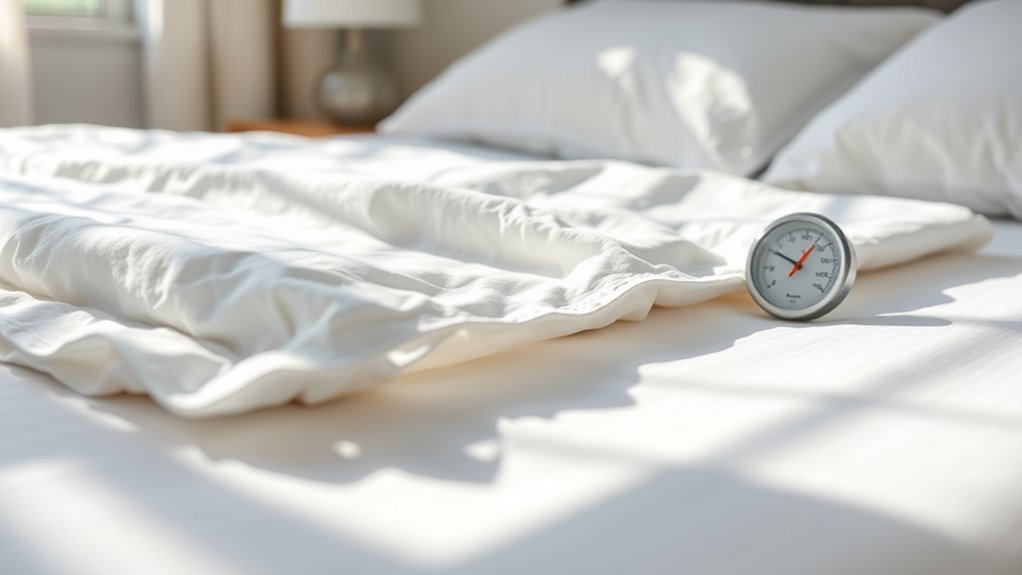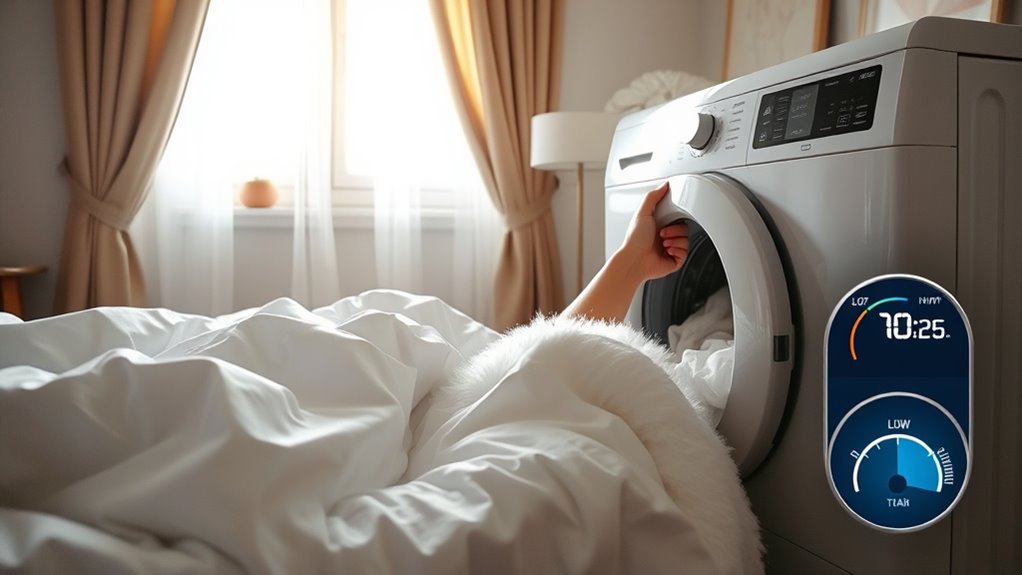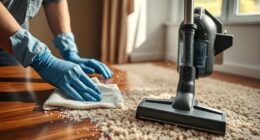To reduce dust mites, start by washing your bedding, including sheets, pillowcases, and blankets, in hot water at least 130°F regularly to kill mites and remove allergens. Keep indoor humidity below 50% using dehumidifiers or air conditioning, since dust mites thrive in moist environments. Regular vacuuming with a HEPA filter and applying allergen-proof covers on mattresses and pillows also help. To find out more tips for a healthier home, keep exploring this topic further.
Key Takeaways
- Wash bedding weekly in hot water (at least 130°F) to eliminate dust mites and allergens.
- Use allergen-proof covers on mattresses and pillows to create a barrier against dust mites.
- Maintain indoor humidity below 50% with dehumidifiers or air conditioning to inhibit dust mite growth.
- Regularly vacuum carpets and upholstery with a HEPA-filter vacuum to reduce dust mite habitats.
- Ensure proper ventilation and fix leaks to control moisture and prevent dust mite proliferation.

Dust mites thrive in your home’s bedding, upholstery, and carpets, but you can substantially reduce their presence with targeted measures. One of the most effective ways to do this is by focusing on allergen avoidance through proper bedding hygiene and controlling the environment’s humidity levels. Regularly washing your bedding in hot water—at least 130°F—destroys dust mites and removes their allergens. This includes sheets, pillowcases, blankets, and mattress covers. Using allergen-proof covers on your mattress and pillows creates a physical barrier, preventing dust mites from colonizing these areas and reducing allergen exposure.
Washing bedding in hot water and using allergen-proof covers reduces dust mite exposure effectively.
Alongside frequent washing, maintaining a clean sleeping environment is crucial. Vacuum your carpets and upholstery regularly with a vacuum cleaner equipped with a HEPA filter. This helps trap dust mites and their waste products, minimizing airborne allergens. Be sure to wash or replace vacuum filters often to ensure optimal performance. Removing clutter from bedrooms and regularly dusting surfaces also limits dust accumulation, further cutting down on dust mite habitats.
Humidity control plays a vital role in dust mite management. Dust mites thrive in environments with humidity levels above 50%. Using a dehumidifier or air conditioner helps keep indoor humidity below this threshold, creating an inhospitable environment for these pests. Monitoring humidity with a hygrometer allows you to maintain consistent, low moisture levels. If you notice increased humidity, especially during humid seasons, take immediate steps to reduce it. Proper ventilation, such as opening windows or using exhaust fans, can also help regulate indoor moisture.
In addition to environmental control, consider reducing indoor moisture sources. Fix leaks promptly, avoid overwatering houseplants, and refrain from drying clothes indoors, which can increase indoor humidity. Using exhaust fans in bathrooms and kitchens helps vent excess moisture outside, maintaining a drier indoor atmosphere.
Implementing a vacuum cleaner with a HEPA filter is essential for effectively capturing dust mites and allergens from carpets and upholstery. Combining allergen avoidance strategies, like washing bedding regularly and using allergen-proof covers, with humidity control measures markedly diminishes dust mite populations. These steps not only improve your comfort but also lessen allergy symptoms and respiratory issues caused by dust mite allergens. Consistency is key—by making these practices part of your routine, you’ll create a less inviting environment for dust mites, leading to a healthier, more comfortable home.
Frequently Asked Questions
How Often Should I Replace My Mattress to Reduce Dust Mites?
You should replace your mattress every 7 to 10 years, depending on its lifespan and condition. Regularly check for signs of wear, sagging, or persistent odors, which indicate it’s time for a replacement. Sticking to a consistent replacement schedule helps reduce dust mites, as older mattresses tend to harbor more allergens. Keeping your mattress fresh and supportive not only improves sleep quality but also minimizes dust mite buildup effectively.
Can Air Purifiers Effectively Eliminate Dust Mites From My Home?
Air purifiers with HEPA filters can substantially reduce dust mites by capturing tiny particles, but they don’t eliminate them entirely. Did you know that dust mites are microscopic and often hide deep in carpets and bedding? These devices improve air exchange, helping lower allergens. To maximize effectiveness, use air purifiers continuously in bedrooms and living areas, and combine this with regular cleaning for a healthier home environment.
Are Dust Mite Allergens Harmful to Healthy Individuals?
Dust mite allergens can still cause problems for healthy individuals by triggering an immune response, even if they don’t have allergies. You might notice allergy symptoms like sneezing or a runny nose. While your immune system is generally strong, exposure to dust mite allergens can still lead to discomfort. It’s wise to take steps to minimize exposure, especially if you notice allergy symptoms, to keep your environment healthier.
What Materials Are Best for Dust Mite-Resistant Bedding?
You know what they say—prevention is better than cure. When choosing dust mite-resistant bedding, opt for hypoallergenic fabrics like tightly woven cotton or microfiber, which prevent mites from thriving. Breathable bedding materials help keep moisture levels low, creating an inhospitable environment for dust mites. These materials not only reduce allergens but also guarantee comfort. Stick to these options, and you’ll build a healthier, more allergen-free sleeping environment.
How Does Temperature Affect Dust Mite Populations Indoors?
You’ll find that higher indoor temperatures can decrease dust mite populations, as they prefer cooler, humid environments. Maintaining ideal humidity levels—below 50%—creates an inhospitable indoor climate for mites, reducing their numbers effectively. Conversely, lower temperatures combined with controlled humidity help keep dust mites at bay. So, by adjusting your indoor climate with warmer temperatures and proper humidity, you can markedly lessen dust mite presence in your home.
Conclusion
By washing your bedding regularly and keeping humidity low, you’re like a gardener tending to delicate plants—creating an environment where dust mites can’t thrive. Imagine a cozy house, open windows, and fresh air keeping pests at bay; that’s exactly what controlling humidity and cleanliness do for you. One person I know saw a noticeable difference after a month, sleeping better and feeling less congested. Small habits make a big difference—protect your space, breathe easier.








